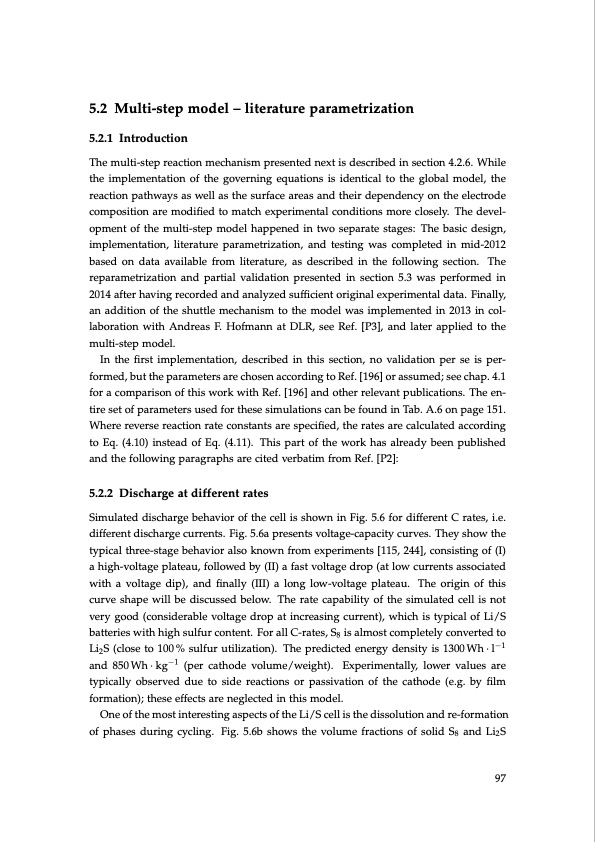
PDF Publication Title:
Text from PDF Page: 097
5.2 Multi-step model – literature parametrization 5.2.1 Introduction The multi-step reaction mechanism presented next is described in section 4.2.6. While the implementation of the governing equations is identical to the global model, the reaction pathways as well as the surface areas and their dependency on the electrode composition are modified to match experimental conditions more closely. The devel- opment of the multi-step model happened in two separate stages: The basic design, implementation, literature parametrization, and testing was completed in mid-2012 based on data available from literature, as described in the following section. The reparametrization and partial validation presented in section 5.3 was performed in 2014 after having recorded and analyzed sufficient original experimental data. Finally, an addition of the shuttle mechanism to the model was implemented in 2013 in col- laboration with Andreas F. Hofmann at DLR, see Ref. [P3], and later applied to the multi-step model. In the first implementation, described in this section, no validation per se is per- formed, but the parameters are chosen according to Ref. [196] or assumed; see chap. 4.1 for a comparison of this work with Ref. [196] and other relevant publications. The en- tire set of parameters used for these simulations can be found in Tab. A.6 on page 151. Where reverse reaction rate constants are specified, the rates are calculated according to Eq. (4.10) instead of Eq. (4.11). This part of the work has already been published and the following paragraphs are cited verbatim from Ref. [P2]: 5.2.2 Discharge at different rates Simulated discharge behavior of the cell is shown in Fig. 5.6 for different C rates, i.e. different discharge currents. Fig. 5.6a presents voltage-capacity curves. They show the typical three-stage behavior also known from experiments [115, 244], consisting of (I) a high-voltage plateau, followed by (II) a fast voltage drop (at low currents associated with a voltage dip), and finally (III) a long low-voltage plateau. The origin of this curve shape will be discussed below. The rate capability of the simulated cell is not very good (considerable voltage drop at increasing current), which is typical of Li/S batteries with high sulfur content. For all C-rates, S8 is almost completely converted to Li2S (close to 100 % sulfur utilization). The predicted energy density is 1300 Wh · l−1 and 850 Wh · kg−1 (per cathode volume/weight). Experimentally, lower values are typically observed due to side reactions or passivation of the cathode (e.g. by film formation); these effects are neglected in this model. One of the most interesting aspects of the Li/S cell is the dissolution and re-formation of phases during cycling. Fig. 5.6b shows the volume fractions of solid S8 and Li2S 97PDF Image | Lithium-Sulfur Battery: Design, Characterization, and Physically-based Modeling

PDF Search Title:
Lithium-Sulfur Battery: Design, Characterization, and Physically-based ModelingOriginal File Name Searched:
Dissertation_David_N._Fronczek_The_Lithium_Sulfur_Battery.pdfDIY PDF Search: Google It | Yahoo | Bing
Sulfur Deposition on Carbon Nanofibers using Supercritical CO2 Sulfur Deposition on Carbon Nanofibers using Supercritical CO2. Gamma sulfur also known as mother of pearl sulfur and nacreous sulfur... More Info
CO2 Organic Rankine Cycle Experimenter Platform The supercritical CO2 phase change system is both a heat pump and organic rankine cycle which can be used for those purposes and as a supercritical extractor for advanced subcritical and supercritical extraction technology. Uses include producing nanoparticles, precious metal CO2 extraction, lithium battery recycling, and other applications... More Info
| CONTACT TEL: 608-238-6001 Email: greg@infinityturbine.com | RSS | AMP |